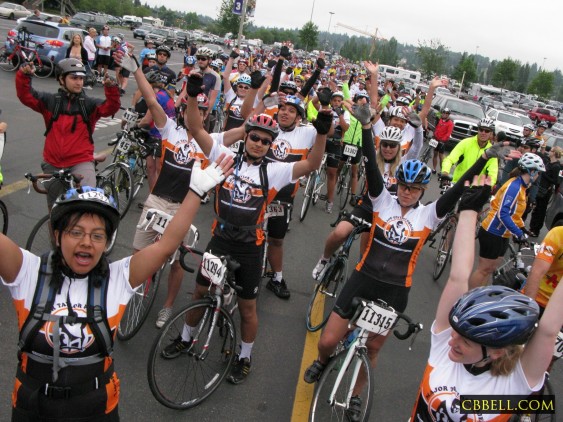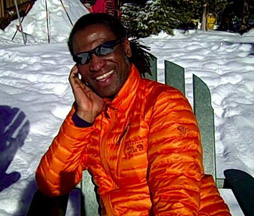Ed Ewing‘s love of cycling started young—on family bike trips and riding to work with his father back in Minnesota. His first bike race was in 1984. He’s been cycling (racing, coaching, and doing outreach) pretty much ever since.
Ewing now directs the Major Taylor Project at Cascade Bicycle Club, a program (which he helped develop, recruited by Ron Sims and Chuck Ayers) to introduce bikes and cycling to under-served youth in low-income and disadvantaged neighborhoods in and around Seattle.
“Bike Clubs” are set up in partnership with schools and other local organizations working with kids. The participants learn about road safety, traffic laws, transportation infrastructure, nutrition, map-reading, and the impact of cycling in their communities. They also ride bikes together, exploring their own city on weekly rides and taking on big challenges like the 206-mile Seattle to Portland Classic (STP).
The project is named after Marshall “Major” Taylor who not only broke race barriers in the sport of cycling, but was the first African-American athlete to achieve the level of world champion.
Ed was kind enough to answer some questions about his work. Here’s our Q&A:
Anna Fahey: When you first meet with a new group of kids, what are their attitudes towards bicycles as transportation?
Ed Ewing: The students we meet are excited for the opportunity to ride. Some have bikes, lots do not; a great deal of their bikes need maintenance and repair. Often, they don’t have money to fix their bikes. Students may use their bikes for transportation to and from school, a job, hanging with friends. But, their scope of transportation needs is limited to their neighborhood or to school.
Using a bike as transportation to travel outside of their environment is new to most, if not all students. We show them how to use local bike maps highlighting bike lanes and their connectivity. We show them how to use a bike with light-rail, the bus, and popular, low traffic routes. At times, we hear the car vs. bike preference: ”I’d rather have a car than a bike”…or…”I can’t go to prom on a bike!”
Having something like the Major Taylor Project—or as students call it ”Bike Club”—legitimizes bikes as acceptable, even ”cool,” means of transportation. They see their friends, teachers, and volunteers who look like them riding, it becomes not so foreign.
The program helps students see the bike as a ”cool” alternative of transportation.
AF: What are the biggest barriers to cycling in the communities you’re working in?
EE: I see three main barriers to cycling in these communities: awareness, access, and support.
First, awareness. For many youth in low income and/or diverse communities, cycling is seldom thought as an alternative to physical activity, fitness, or transportation. Traditional sports and recreation—basketball, football, soccer—are what you see on TV and are traditionally offered in school, so that’s what you do. There’s also the expectation to own a car because in some cases, a car equals status.
Many of these youth are raised in households where cycling is not the norm. There is limited knowledge of the cycling community.

AF: How does Seattle stack up as a bike-friendly city? What are we doing well, and what are the city or county’s biggest shortcomings?
EE: We have done well implementing the 2007 Bicycle Master Plan, but that plan is now sorely outdated when compared to what cities like Chicago, New York, Portland, Vancouver BC, and Minneapolis are doing right now.
We are one of the few major cities in the country that hasn’t built any protected infrastructure through the downtown core and much of what we continue to build only appeals to people that already ride. We need to do a better job building infrastructure that connects our neighborhoods and gets people to our business districts, including downtown, that is safe, convenient, and comfortable for anyone who wants to ride.
Some things have been done like the Dexter buffered bike lanes, and some street safety improvement projects such as Nickerson and 125th. However, Seattle and the region have not kept up on the infrastructure necessary to get people eight years old to 80 years old on bicycles—regardless of their race, gender, culture, ethnicity or anything else that makes us diverse.
Next, access: There is a financial barrier to cycling. Like golf, tennis, or swimming, a bike costs money. In several of these communities, food, shelter, and general living expenses, are the urgent priorities for students and families. Over 70 percent of students in these communities and in the Major Taylor Project, receive ‘Free or Reduced’ lunch assistance, and the average lunch costs $3.50.
If you do have the money for a bike, then where do you start? We’re finding a great deal of students don’t know where to start in buying a bike or where to bike. How much money do I need and do I need a bike lane?
Then, support: As a teen, it can be scary trying new things. They say: ”It’s different than what my friends are doing and I don’t see any adults doing this.” Youth need support and guidance in trying something new. They will model behavior of peers and adults they respect. Swim lessons need a lifeguard, golf and tennis need a coach, and cycling needs adult volunteers to model behavior. In many cases, the parents are not involved because of job requirements, low understanding of cycling and its benefits, or they’re just not in the picture. Consistent, long term community support, is also important. In order to affect change, we understand that the Major Taylor Project is more than a one year commitment.

AF: What can bicycle advocates do to reach out beyond “the choir” of dedicated transportation wonks? Are there lessons you’ve learned when it comes to communicating about transportation policies and bicycling?
EE: What bicycle advocates can do to extend their reach? Ask diverse groups and communities for input, and build allies.
AF: What are some ways that the kids you’re working with link their own new-found joy and personal satisfaction from bicycles with big picture issues like the environment, health, economic justice, and climate change?
EE: Great question. In April, we held our first Major Taylor Project Youth Leadership Retreat with 20 students, representing all five Major Taylor clubs. Over the weekend, we explored leadership, race, diversity, community, the environment, and their relation to cycling. High school juniors and seniors have a 30-40 hour community service requirement to graduate, called their ‘Activism’ project. The Leadership Retreat students selected these five topics for their Activism projects; Education, Environment, Building Community, Biking, and Healthy Food.
One student, Oliyad Beyene of Global Connections High School, completed four years with the Major Taylor Project. For his senior project, Olyiad studied the need for bike lanes and the impact of cycling, in the SeaTac community. In tandem with Cascade’s advocacy department, Oliyad surveyed 100 of his peers and community members and presented his findings to City of SeaTac officials. He is featured in a video about the program that gives you a good idea.
AF: So, how many kids in King County have their own bikes now because of this program?
EE: One hundred!
AF: And growing all the time! What do you see as the lasting impacts, not just for those individual kids, but for the community and the area as a whole?
EE: I see a host of lasting impacts for the kids. The Major Taylor Project is more than bikes, it’s about where the bike can take you. It’s about the new experiences they have because of the bike. For several of these students, the bike is allowing them to explore their world for the first time. They’re exploring and learning new things about their community. They become resourceful in leaning how the bike can be used for transportation, how it connects with Light Rail, with Metro, and how to read a map of popular bike routes. This helps them to become empowered which leads to self-esteem and confidence.
Several students have recognized the differences in their community compared to other neighborhoods, perhaps more affluent. They’ve noticed how some communities have grocery stores instead of corner stores selling chips, candy, and various unhealthy items. They notice how some communities have bike lanes and theirs do not. They notice the quality and contents of the streets, some smooth, others filled with potholes and glass. They notice some communities have libraries and others do not. These observations turned into questions and action. They’ve started asking questions about diversity, access to healthy food, fitness, and making their communities more bike friendly.
Next steps are to pair students with mentors and members of their community and put their ideas into action. This process will hopefully bring attention and change to their communities.
AF: Personally, what motivates you to do the work that you do?
EE: My upbringing and the experiences I had as a student and young adult are my motivations. I was raised in an African-American community and bussed to private school for K-12. My parents worked very hard and I realize the sacrifice they made to provide for and educate my brother and me. They are excellent role models and shared their passion for biking as a family recreation.
Before starting the Major Taylor Project, I had been away from high school for several years. When I got a look at local high schools, I was encouraged by some and shocked by others. I was unaware that in some schools 70 percent and in others, above 80 percent, of students receive lunch assistance. I was unaware that school was the most stable thing in the life of many and lunch was the only meal of the day. I know what cycling has done for me and I see that possibility for others. I see it as a means of recreation, experience, access, and empowerment.
Regardless of race, ethnicity, gender, or socioeconomic status, everyone should have access to a bike and safe streets to ride. Many students do not have the upbringing that I had. I want to make sure that they have opportunities. The bike has transformed my life; I want to transform their life with a bike.

